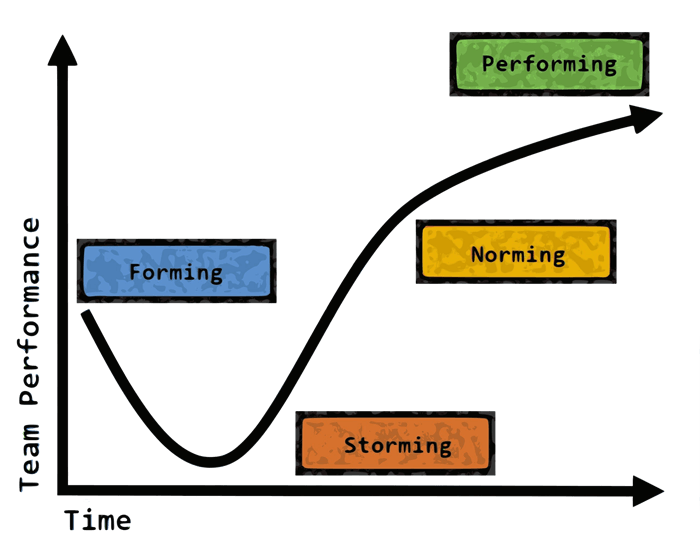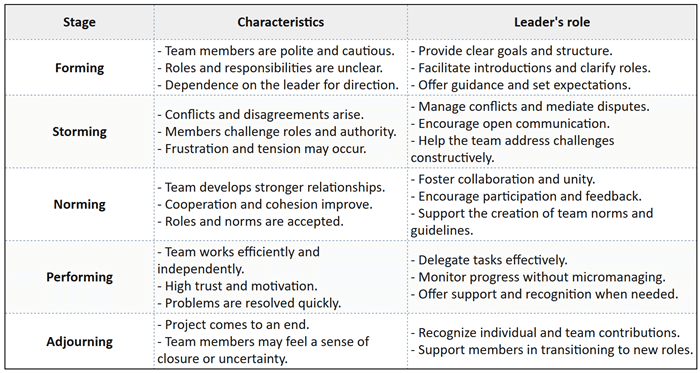What really is Teamwork? Tips and necessary skills to make your team thrive

Teamwork, or group work, is the ability to work together. It is also considered one of the most important soft skills for every individual.
But what exactly is teamwork? Why do we need it? What is the formula to maximize the power of teamwork in organizations and businesses? Let's explore the detailed information in this article.
What is teamwork?
Definition of teamwork
Teamwork, or group work, refers to the coordination and collaboration process between two or more individuals to accomplish tasks and achieve a common goal.
With teamwork, the overall task is divided into smaller, more manageable assignments. Each person is assigned a task that aligns with their skills and expertise. Teamwork is essential across most organizations, businesses, and industries.
Characteristics of teamwork
Effective teamwork has four key characteristics: interaction, specialization, unity, and discipline. Let's break these down:
- Interaction: Interaction acts like the "glue" that connects individuals who might otherwise work independently into a cohesive team. Members must collaborate and support each other to complete the assigned tasks.
- Specialization: Each team member brings unique expertise to the table. While it's not necessary for everyone to be a jack-of-all-trades, they must excel in their specific roles.
- Unity: Unity creates a shared voice within the group, ensuring the team operates smoothly and remains aligned throughout the process.
- Discipline: Discipline means setting clear rules that each team member is expected to follow. This keeps the team focused on their goals and ensures everyone knows their responsibilities.
Why do we need teamwork?
Teamwork is about collective effort, but often, a few people end up doing most of the work due to poor task distribution or lack of accountability. There's a saying: "If you want to go fast, go alone. If you want to go far, go together." It’s no surprise that teamwork is seen as a vital skill in most job descriptions.
Teamwork not only builds a positive work environment but also promotes individual growth. Here are four key benefits:
- Boosting productivity: When creative minds collaborate, tasks become easier, reducing the burden on everyone. This allows everyone to perform at their best and boosts job satisfaction, which leads to better employee retention.
- Creating unity and consensus: Effective teamwork fosters camaraderie and shared purpose. Without it, individuals may focus on their own goals, creating a competitive and negative work atmosphere.
- Sparking creativity and problem-solving: Teamwork brings together different perspectives, helping the group find the best solutions. This diversity of thought makes tackling challenges easier.
- Opening opportunities for learning and growth: Team members can share knowledge and experiences, helping each other grow. This not only enhances their understanding but also builds critical soft skills like communication, leadership, and problem-solving.
4 stages of team development
According to an American psychologist - Dr. Bruce Tuckman, a working group typically goes through several stages of development. By recognizing these stages, leadership can assess the team's current position or identify obstacles, enabling them to find solutions to ensure the team achieves high performance.

We have already discussed these four stages of team development in another article, but let's head to a quick overview of the framework.
Stage 1 – Forming
In the Forming stage, the team comes together, and members start getting to know each other and the task at hand. The atmosphere is generally positive, as members are excited about the new challenge and eager to get started. However, this stage is also marked by observation and cautious decision-making as everyone is still finding their footing.
Stage 2 – Storming
This is usually the most challenging phase of team development and can create tension, frustration, and even undesirable outcomes if not managed properly.
This phase can also be seen as a turning point when members learn each other’s strengths, weaknesses, and communication styles. To move forward, it’s crucial that the team faces these conflicts head-on and works together to resolve issues, pushing them closer to the next stage of development.
Stage 3 – Norming
This stage occurs when team members accept differences, recognize each other's strengths, and show more respect for one another.
Communication becomes more fluid, with members consulting each other and seeking help when needed. New working rules are often established to minimize unnecessary conflict and debate.
Team performance improves significantly during this stage as the group focuses more on their collective goals.
Once most conflicts are resolved, the team moves on to the next stage.
Stage 4 – Performing
At this stage, the team reaches its highest level of performance and relies less on supervision. This is the result of overcoming challenges from the previous stages. While discussions still occur, any issues are quickly and efficiently resolved.
Stage 5 - Adjourning
This occurs when a project is completed, when most members leave the group, or during organizational restructuring. It marks the end of the team's journey, and for many, it can be an emotional moment.
5 common mistakes to avoid in teamwork
1. Lack of trust
This issue arises when team members fear criticism and hesitate to share their strengths and weaknesses. Without mutual trust, teamwork suffers significantly.
When trust is missing, several adverse outcomes can occur. Instead of focusing on their tasks, the team spends time and energy dealing with internal conflicts. Members may be reluctant to engage in meetings, ask for help, or offer support to their colleagues.
As a result, team morale drops, productivity declines, and the project is at risk of failing. In some cases, individuals may choose to leave the team or resign from the organization.
2. Fear of conflict
When teamwork lacks trust, a second issue arises: the fear of conflict. However, it’s crucial for team members to differentiate between types of conflict—whether it’s constructive, an attack, or the result of avoiding and sidestepping important issues.
Teams that avoid debate and prioritize harmony over progress often find themselves stuck. Problems remain unresolved, eventually hitting a "dead end" with no clear solution. To break through this, every team member must put aside personal egos and engage in open, constructive discussions that drive the team toward its common goal.
Constructive conflict fosters confidence during meetings and allows for more effective problem-solving. Once the debate is over, the team can move forward without lingering on past disagreements, ensuring smoother progress.
3. Lack of commitment
The absence of constructive conflict leads to the third mistake in teamwork: lack of commitment. This occurs when team members merely "pretend" to agree during meetings but rarely or never invest their full effort in the tasks assigned.
This issue is particularly harmful because it creates hidden tensions within the team. Members may appear to go along with decisions, but their lack of real engagement undermines progress.
Let’s compare the traits of a committed team versus one lacking commitment:

4. Shifting responsibility
Passing the buck, avoiding responsibility, and blaming others are detrimental behaviors in teamwork. To address this dilemma, managers must identify the root cause of the issue. Some reasons include:
- Poor governance systems create overlapping authority and responsibilities, leaving employees unclear about their roles. This confusion often leads to shifting responsibilities, particularly between newer and more experienced staff.
- A lack of strong leadership or strict accountability from management further encourages team members to avoid responsibility, setting a tone where no one feels compelled to take ownership.
- Insufficient skills or expertise within the team leads to fear of failure, causing members to hesitate in taking on tasks, further slowing progress and productivity.
5. Lost focus on shared goals
Another common mistake in teamwork is neglecting the group’s goals in favor of personal interests. In such cases, members may focus solely on their own benefits, forgetting the team's collective goals.
It’s crucial to remember that a project’s success depends on the contributions of all team members. When everyone works in a fragmented manner, focusing only on their individual tasks, the overall results suffer. To avoid this, individual responsibilities must always align with the organization's shared objectives.
Essential skills for effective teamwork
For team leaders
Team development skills
Team building and development skills refer to the ability to lay a strong foundation, guide, and support the team to achieve optimal work performance. A good leader fosters a healthy and cohesive team environment and encourages members to maximize their professional capabilities.
Relationship management skills
One key quality of a successful team leader is empathy. Leaders need to understand the perspectives, work, and concerns of each team member, creating a supportive and cohesive team dynamic.
Strong relationship management skills allow leaders to connect with team members and foster collaboration toward shared goals. Leaders should be ready to step in and provide guidance when team members face challenges, ensuring no one feels left behind.
Empathy also extends to conflict resolution. A great leader must be able to negotiate and persuade team members to resolve disputes effectively, ensuring that everyone is content with the final outcome.
Problem-solving skills
A team leader must have foresight and strong analytical skills to recognize market trends and identify the best solutions for the team's success. In addition to spotting these opportunities, they should effectively share their insights with the team, inspiring and motivating members to adapt to changes and stay ahead of the competition. This ability to lead with vision not only drives the team’s success but also builds confidence in the leader’s guidance.
For team members
Communication skills
Effective communication is the key to successful teamwork. In discussions, individuals must communicate openly and honestly. While disagreements are inevitable, being straightforward and respectful helps resolve issues quickly.
Collaboration skills
Collaboration is at the heart of effective teamwork. It involves more than just working together; it requires actively contributing ideas, respecting diverse perspectives, and being open to feedback. A collaborative team member is proactive in sharing knowledge, brainstorming with others, and looking for ways to help the team move forward.
Critical thinking skills
Critical thinking allows team members to defend their opinions if they believe they are necessary and beneficial.
Critical thinking isn't just about opposing others' ideas; it involves presenting clear arguments, making objective and reasonable assessments, and supporting one's viewpoint. This ensures that the best decisions are made for the team.
How to boost teamwork in the workplace
Align on organizational direction
A clear and consistent direction is a strong motivator for employees. When team members understand how their work ties into the organization’s bigger goals, they feel more confident and engaged.
Take, for example, a global team study by Harvard Business Review (HBR). The goal for all employees was to serve customers in the best way possible. But what "best" meant varied. In Norway, employees believed it meant offering high-quality products no matter the cost. In the UK, they defined it as meeting 75% of customers' needs. To fix this, HBR led a direct discussion to align everyone’s goals.
Alignment is even more critical for companies with multiple offices or remote workers. It’s crucial that everyone shares the same understanding of the organization’s goals.
Design a rational team structure
For teams to be highly productive, having the right mix of skills, work styles, and the right number of members is essential. According to HBR, skill balance is crucial for team success. No member needs to have all the skills, but the team should have a diverse range of abilities. To achieve this, it’s important to bring in people from different backgrounds regarding age, gender, knowledge, and expertise.
However, diversity should be balanced with team size. Adding more people isn’t always the answer. Before recruiting someone new, businesses should evaluate how the candidate can add to the team’s overall performance.
Careful task delegation is also crucial. Teams should be responsible for managing an entire project or task from start to finish, rather than just being assigned random duties. Each member should have the freedom to work independently, but also receive timely feedback and evaluations.
Use supporting tools
The third key factor that boosts teamwork in a business environment is modern work tools. These tools can include:
- Reward systems for top-performing individuals
- Centralized information system that houses all necessary work data
- Internal training and education programs
- Enterprise management software
There is no one-size-fits-all solution when it comes to the perfect tools for a team, so you can start with the most essential and suitable options for your business (Rework can be a good start 😉).
Sharing mindset
According to HBR's analysis, teams in the past were often made up of stable groups of like-minded individuals who worked closely together and tended to think similarly. Nowadays, teams often consist of smaller, independent groups with minimal collaboration and sharing.
The study refers to this as a “natural human response” to the increasing complexity of the world, where people tend to divide tasks and take shortcuts.
This is a disadvantage for team productivity because some members may have access to critical information that others don’t, and the lack of sharing—whether due to geography or a "minding your own business" mentality—limits the team’s potential. This is unfortunate because such information could provide key insights or evidence that would help the team better understand each other and significantly improve results.
In other words, shared knowledge is the foundation of effective collaboration.
In conclusion
Effective teamwork is not just about bringing people together but about creating a culture where collaboration thrives and every team member feels empowered to contribute their best.
This article has explored the importance of teamwork and shared strategies for improving group productivity within organizations. We hope these ideas help your business strengthen and develop effective teams for future success.
